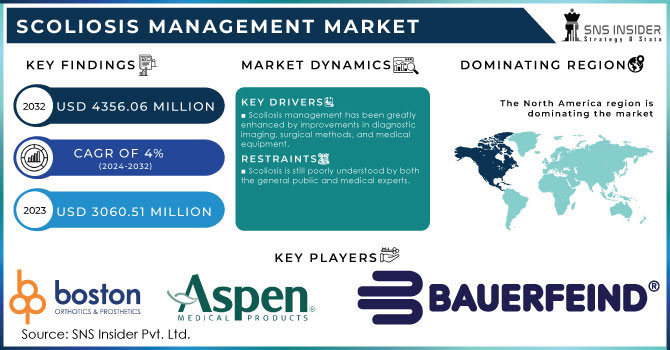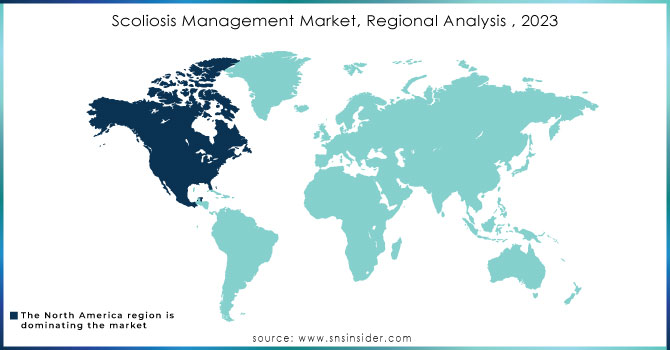Scoliosis Management Market Report Scope & Overview:

To Get More Information on Scoliosis Management Market - Request Sample Report
The Scoliosis Management Market size was USD 3060.51 Million in 2023 and is expected to Reach USD 4356.06 Million by 2032 and grow at a CAGR of 4% over the forecast period of 2024-2032.
The Scoliosis Management Market refers to the market for products and services aimed at diagnosing, treating, and managing scoliosis. Scoliosis is a medical condition characterized by an abnormal curvature of the spine, typically in an "S" or "C" shape. It can affect people of all ages, but it most commonly develops in adolescence. The market for scoliosis management includes various products and services that are used for the diagnosis, monitoring, and treatment of scoliosis. Orthopedic braces are commonly used to manage scoliosis, especially in children and adolescents with moderate curvature. These braces help in preventing further progression of the spinal curve by providing support and stability to the spine. In severe cases of scoliosis, surgical intervention may be required. Surgical devices such as rods, screws, and hooks are used to correct the spinal curvature and stabilize the spine. These devices are often made from biocompatible materials like titanium or stainless steel. Advanced imaging technologies like X-ray, MRI, and CT scans are used for accurate diagnosis, monitoring, and evaluation of scoliosis. These imaging systems help in assessing the severity of the curvature and assist in planning the appropriate treatment approach. Physical therapy plays a crucial role in managing scoliosis. Therapeutic exercises, stretching, and strengthening programs are designed to improve muscle strength and flexibility, promote spinal alignment, and prevent further progression of the curvature.
Various tools and technologies are available to monitor and assess the progression of scoliosis. These may include electronic measurement devices, wearable sensors, and computerized systems that provide objective data on spinal curvature and help in tracking the effectiveness of treatment. Additionally, the market may include supportive products like orthopaedic pillows, mattresses, and seating systems designed to provide comfort and proper spinal alignment for individuals with scoliosis. The scoliosis management market is driven by factors such as the increasing prevalence of scoliosis, advancements in diagnostic and treatment technologies, growing awareness about early intervention, and the rise in research and development activities. It is a dynamic and competitive market, with various companies, including medical device manufacturers, orthopaedic clinics, and healthcare providers, offering a range of products and services to meet the needs of individuals with scoliosis.
MARKET DYNAMICS
DRIVERS:
-
Scoliosis management has been greatly enhanced by improvements in diagnostic imaging, surgical methods, and medical equipment.
The market is being driven by rising infrastructure spending on healthcare.
The growing cost of healthcare, which aids in developing the market's infrastructure, is another important aspect impacting the market's growth rate. Growth and growth of the healthcare sector, particularly in emerging nations, would encourage the adoption and use of cutting-edge medical tools, technology, and medications. The need for scoliosis therapy will consequently rise.
RESTRAIN:
-
Scoliosis is still poorly understood by both the general public and medical experts.
-
The main restraining factor in this sector is high treatment costs.
The expense of treating scoliosis, including the price of diagnostic procedures, braces, surgical procedures, and physical therapy, can be high. The cost of therapy can occasionally operate as a barrier, especially for those without access to cheap healthcare or enough insurance coverage. High treatment costs might prevent some solutions from being adopted and have an impact on the market's overall growth.
OPPORTUNITY:
-
Ongoing developments in imaging technology, surgical procedures, and medical equipment.
-
Increasing Minimally Invasive Technique Adoption is a big industry potential.
In the treatment of scoliosis, less invasive surgical methods including endoscopic and laparoscopic procedures are becoming more and more common. Potential advantages of these methods include fewer incisions, less tissue stress, shorter hospital stays, and quicker healing. The growing use of less invasive procedures offers chances to enhance patient outcomes and lessen surgical complications.
CHALLENGES:
-
It may be quite difficult to get patients to comply with scoliosis care procedures like bracing and physical therapy.
-
Another significant obstacle in this business is psychological and emotional impact.
Scoliosis can significantly affect a person's mental and emotional state, especially in teens. Acceptance of and adherence to therapy may be impacted by challenges with body image, self-esteem, and societal stigma. Better outcomes depend on addressing patients' psychological needs and offering them support throughout their scoliosis therapy journey.
IMPACT OF RUSSIA-UKRAINE WAR
Businesses are under pressure to source more manpower in addition to alternate materials. Since the start of the conflict, Eastern Europe has seen a labor supply shortage, which has once more boosted prices. According to figures from the International Chamber of Shipping (ICS), Russians make up 11.5% (199,123) of the world's shipping workforce, with Ukraine contributing 77,542 (or 6%). Particularly for labor-intensive applications moving away from Eastern Europe, many corporations are increasingly looking into opportunities in Africa and South America. In this field manpower is a basic need to develop the machine. In future the scoliosis management services will be more costly.
IMPACT OF ONGOING RECESSION
According to experts, medical device makers are prepared to withstand a downturn in the economy even as they continue to deal with pandemic-related challenges including workforce shortages and enduring supply chain problems. Device makers aren't fully immune to possible recessionary pressures, but the sector should be able to withstand a recession that becomes worse. Effects of the ACA may contribute to more steady procedure volumes. In early 2022, a record number of over 38 million individuals received insurance under the ACA, while 30 million people remained uninsured, down from 47.2 million in the same period the previous year, according to the Department of Health and Human Services. In this database no major impact ongoing recession on Scoliosis Management Markets.
KEY MARKET SEGMENTATION
By Type
-
Spinal system
-
Orthosis system
By Disease Type
-
Degenerative scoliosis
-
Idiopathic scoliosis
-
Neuromuscular scoliosis
-
Others
By Age
-
Pediatrics
-
Adults
REGIONAL COVERAGE:
North America
-
US
-
Canada
-
Mexico
Europe
-
Eastern Europe
-
Poland
-
Romania
-
Hungary
-
Turkey
-
Rest of Eastern Europe
-
-
Western Europe
-
Germany
-
France
-
UK
-
Italy
-
Spain
-
Netherlands
-
Switzerland
-
Austria
-
Rest of Western Europe
-
Asia Pacific
-
China
-
India
-
Japan
-
South Korea
-
Vietnam
-
Singapore
-
Australia
-
Rest of Asia Pacific
Middle East & Africa
-
Middle East
-
UAE
-
Egypt
-
Saudi Arabia
-
Qatar
-
Rest of Middle East
-
-
Africa
-
Nigeria
-
South Africa
-
Rest of Africa
-
Latin America
-
Brazil
-
Argentina
-
Colombia
-
Rest of Latin America
REGIONAL ANALYSIS
North America: Due to a rise in scoliosis-related hospital visits and procedures, the scoliosis management market in North America is predicted to develop quickly in the years ahead. Nearly 30,000 adolescent scoliosis procedures are performed annually in the United States, according to the CLEAR Scoliosis Institute, which favors the use of scoliosis spinal systems in North America.
Asia Pacific & Europe: The increased incidence of idiopathic scoliosis and government assistance through financing and awareness campaigns are both factors contributing to the market growth for scoliosis management in Europe and the Asia Pacific over the forecast period. The British Scoliosis Research Foundation awards grants to competent specialists for scoliosis research in the U.K., which is anticipated to spur the growth of scoliosis treatment alternatives in Europe.

Do You Need any Customization Research on Scoliosis Management Market - Enquire Now
Key Players
Some major players in Scoliosis Management Market are Aspen Medical Products, Boston Orthotics & Prosthetics, Bauerfeind AG, Chaneco, Fited, Inc., Enovis, Orthotec, Lawall Prosthetics and Orthotics, Horton’s Orthotics & Prosthetics, Optec USA, Inc. and other players.
RECENT DEVELOPMENTS
Convexity Scientific: In 2020, Convexity Scientific purchased Wellinks Inc. The corporation would earn more from this purchase by gaining a bigger portion of the market.
Green Sun Medical: In 2020, For those with teenage idiopathic scoliosis, Green Sun Medical is undertaking pilot research to create a dynamic scoliosis brace.
| Report Attributes | Details |
| Market Size in 2023 | US$ 3060.51 Mn |
| Market Size by 2032 | US$ 4356.06 Mn |
| CAGR | CAGR of 4% From 2024 to 2032 |
| Base Year | 2023 |
| Forecast Period | 2024-2032 |
| Historical Data | 2020-2022 |
| Report Scope & Coverage | Market Size, Segments Analysis, Competitive Landscape, Regional Analysis, DROC & SWOT Analysis, Forecast Outlook |
| Key Segments | • By Type (Spinal system, Orthosis system) • By Disease Type (Degenerative scoliosis, Idiopathic scoliosis, Neuromuscular scoliosis, Others) • By Age (Pediatrics, Adults) |
| Regional Analysis/Coverage | North America (US, Canada, Mexico), Europe (Eastern Europe [Poland, Romania, Hungary, Turkey, Rest of Eastern Europe] Western Europe] Germany, France, UK, Italy, Spain, Netherlands, Switzerland, Austria, Rest of Western Europe]). Asia Pacific (China, India, Japan, South Korea, Vietnam, Singapore, Australia, Rest of Asia Pacific), Middle East & Africa (Middle East [UAE, Egypt, Saudi Arabia, Qatar, Rest of Middle East], Africa [Nigeria, South Africa, Rest of Africa], Latin America (Brazil, Argentina, Colombia Rest of Latin America) |
| Company Profiles | LLC, Aspen Medical Products, Boston Orthotics & Prosthetics, Bauerfeind AG, Chaneco, Fited, Inc., Enovis, Orthotec , Lawall Prosthetics and Orthotics, Horton’s Orthotics & Prosthetics, Optec USA, Inc. |
| Key Drivers | • Scoliosis management has been greatly enhanced by improvements in diagnostic imaging, surgical methods, and medical equipment. |
| Market Restraints | • Scoliosis is still poorly understood by both the general public and medical experts. • The main restraining factor in this sector is high treatment costs. |

